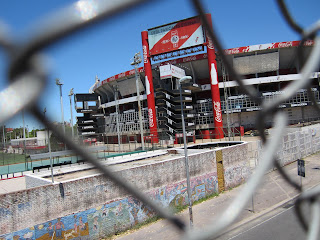Towards the end of our trip to Argentina, the Learning Cluster group met (via Skype and in person, respectively) with Javier Campo and Pablo Piedras, to speak about the role of documentary cinema in Argentine history and memory preservation. Pablo and Javier are each separately involved in research on human rights and crimes of the dictatorship, and together they are the editors of the online magazine Revista Cine Documental: http://www.revista.cinedocumental.com.ar/
Our conversation began on Skype with an overview of the work Javier Campo has done recently. He spoke about his book, Cine Documental, Memoria y Derechos Humanos, and about the importance of human rights research. Along with Pablo, he feels that every Argentinean has in some way been affected by the dictatorship and its crimes against humanity. Pablo shared personal anecdotes about his own father that further illustrated this point. Through our conversation, it became abundantly clear that the dictatorship’s crimes shocked Argentinean society to its very core.
 |
| Pablo Piedras, Photo by Norito Hagino |
The first of these three classifications categorizes film that was produced during and shortly after the dictatorship. During those years, military juntas took control of a large portion of Argentine broadcast media and greatly obscured public knowledge of their activities. Using this influence, members of the juntas produced films designed to shed the government and its anti-subversion resistance in a positive light. Though the images in these films are rarely seen, their narratives are biased. The cinema created by and for the Juntas portrays the Argentine struggle as though it was a war, the Juntas against subversion. Truthfully, it is hard to know whether or not this was the case. After the Malvinas War, the military government of the Juntas crumbled, clearing the way for democratization in Argentina. The transition process was not a clean one. In their fall, amidst audits and trials for the crimes against humanity committed, the Juntas did their best to destroy all compromising images that could lead their prosecutors to victory.
Years later, as documentary filmmakers attempted to compile material for documentaries about the dictatorship they encountered a very serious lack of images in the wake of this censorship. This lack of archival images about the dictatorship leads us to the second defined era of Argentine documentary cinema. Films produced during this second batch of documentaries rely heavily on the direct survivor testimony to describe state terrorism. In the absence of material with which to show the viewer a story, these documentaries generally allow a heavy handed testimony to lead the audience rather than presenting information objectively. Films during this period, such as Juan Como Si Nada Hubiera Sucedido, took on issues from an entirely different perspective than those produced directly by the dictatorship, but because of small private production and no distribution, few people saw them.
 |
| Photo by Norito Hagino |
At this point many of the films being made are investigations. Personal family archives are used to piece together shattered stories that the military Juntas left behind and unlike previous filmmakers, sons and daughters rarely create rounded stories with all questions answered. These films work to preserve memory in contemporary life so that in the future tragedies like that of the desaparecidos never are allowed to happen again. Nunca mas.




















































